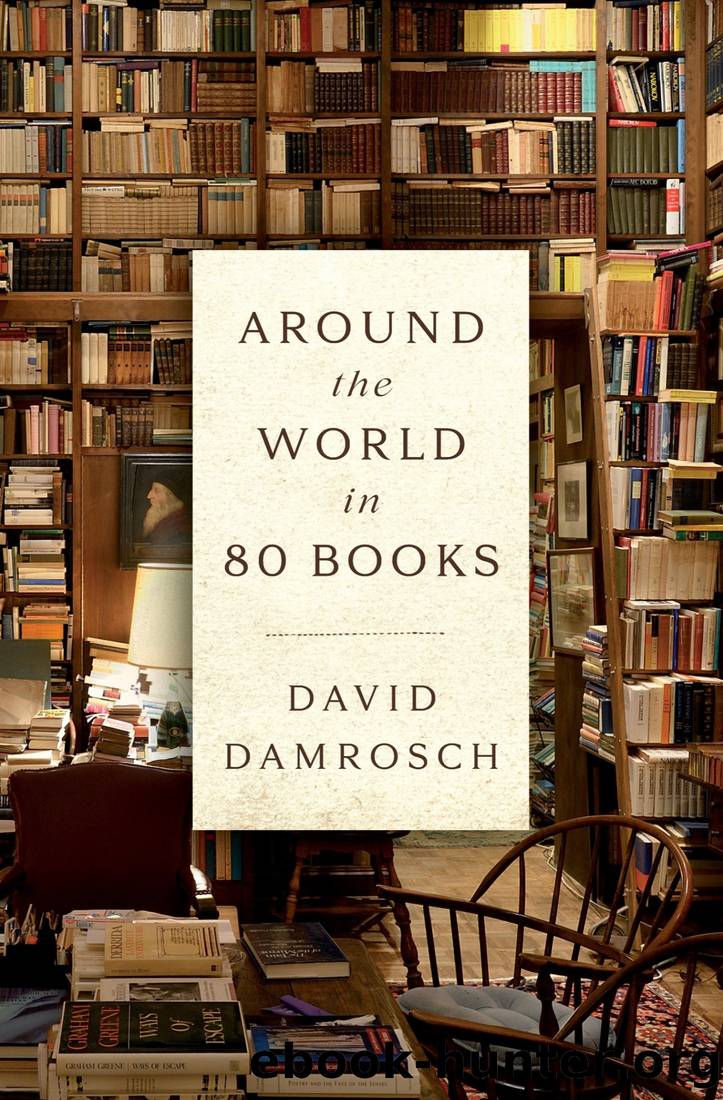Around the World in 80 Books by David Damrosch

Author:David Damrosch [Damrosch, David]
Language: eng
Format: epub
Published: 2021-11-16T00:00:00+00:00
CHAPTER TEN
ShanghaiâBeijing: Journeys to the West
46. Wu Chengâen, Journey to the West
Moving eastward from India to China, we begin with a novel that moves westward from China to India. Journey to the West is based on an actual journey by a seventh-century monk named Xuanzang, who spent seventeen years traveling and studying in Central Asia and India. He finally returned to China in 645 with a trove of more than 600 Buddhist treatises, and he spent the rest of his life working with a team of colleagues to translate the Sanskrit originals and to write commentaries on them. Master Xuanzangâs emperor asked him to write down the story of his epochal journey, and nearly a millennium later, his Great Tang Records of the Western Regions became the basis for one of the âFour Classicsâ of traditional Chinese fiction.
Published anonymously in 1592, Journey to the West is usually attributed to Wu Chengâen, a minor official in the Ming Dynasty. In Wuâs account, Master Xuanzang is called Tripitaka, or âThree Baskets,â referring to three categories of Buddhist texts he brought home. He travels with four fanciful companions provided for him by Guanyin, the Goddess of Mercy: a reformed river ogre, a humanized pig, a dragon-turned-horse, and most importantly a loquacious and unruly monkey, Sun Wukong or âMonkey Awakened to Emptiness.â Together, they become a sort of Fellowship of the Sutras. In the course of a hundred chapters, they surmount eighty-one dangers and ordeals, from wild animals to bandits to demons, before finally reaching their goal in India, where they receive the gift of scriptures from the Buddha himself.
The historical Xuanzang was a pilgrim who ventured to India despite an imperial ban on foreign travel, but Wu Chengâen adds a Confucian emphasis. He makes Tripitaka a faithful servant of his emperor, who commissions him to seek out the scriptures, and the opening and closing chapters frame the tale within sixteenth-century concerns over imperial governance and the growth of bureaucracy. Further, the eighty-one adventures that occupy the bulk of the narrative feature alchemical practices and magical transformations common to popular Daoism. Whereas Xuanzang was devoted to textual analysis and philosophical debate, Wuâs narrative reflects a Daoist understanding of the world as fundamentally a mental construct, with meaning best grasped through wordless meditation. At one point, Tripitaka and Sun Wukong are arguing over the meaning of a key Sanskrit text, the Heart Sutra: âââApe-head!â snapped Tripitaka. âHow dare you say that I donât know its interpretation! Do you?âââ Sun Wukong insists that he does, but then falls silent. When the pig and the ogre mock him as too ignorant to respond, Tripitaka reproves them. âStop this claptrap!â he says; âWukong made his interpretation in a speechless language. Thatâs true interpretation.â1
According to the novel, the Buddha has observed that in China, âthey are greedy, lustful, murderous and quarrelsome. I wonder whether a knowledge of the True Scriptures would not cause some improvement in them?â And so he inspires Chinaâs emperor to send a pilgrim to receive his âthree basketsâ of scriptures.
Download
This site does not store any files on its server. We only index and link to content provided by other sites. Please contact the content providers to delete copyright contents if any and email us, we'll remove relevant links or contents immediately.
| Africa | Americas |
| Arctic & Antarctica | Asia |
| Australia & Oceania | Europe |
| Middle East | Russia |
| United States | World |
| Ancient Civilizations | Military |
| Historical Study & Educational Resources |
Never by Ken Follett(2881)
The Man Who Died Twice by Richard Osman(2300)
Machine Learning at Scale with H2O by Gregory Keys | David Whiting(2291)
Fairy Tale by Stephen King(2070)
Will by Will Smith(2042)
Rationality by Steven Pinker(1765)
The Dawn of Everything: A New History of Humanity by David Graeber & David Wengrow(1571)
The Dark Hours by Michael Connelly(1570)
Principles for Dealing With the Changing World Order: Why Nations Succeed and Fail by Ray Dalio(1373)
Friends, Lovers, and the Big Terrible Thing by Matthew Perry(1328)
A Short History of War by Jeremy Black(1300)
HBR's 10 Must Reads 2022 by Harvard Business Review(1256)
Go Tell the Bees That I Am Gone by Diana Gabaldon(1234)
Can't Hurt Me: Master Your Mind and Defy the Odds - Clean Edition by David Goggins(1227)
515945210 by Unknown(1208)
Fear No Evil by James Patterson(1109)
443319537 by Unknown(1073)
Works by Richard Wright(1018)
Going There by Katie Couric(992)
